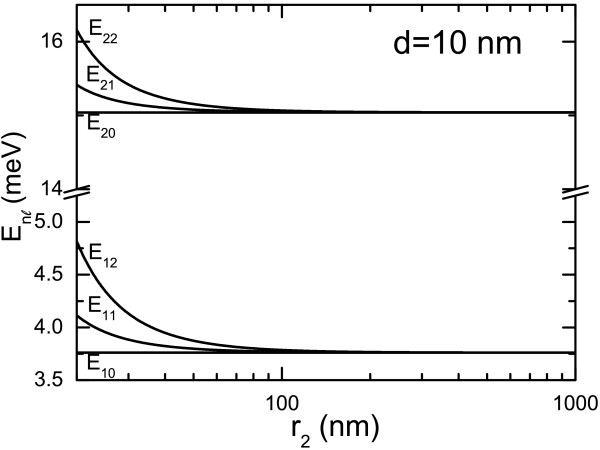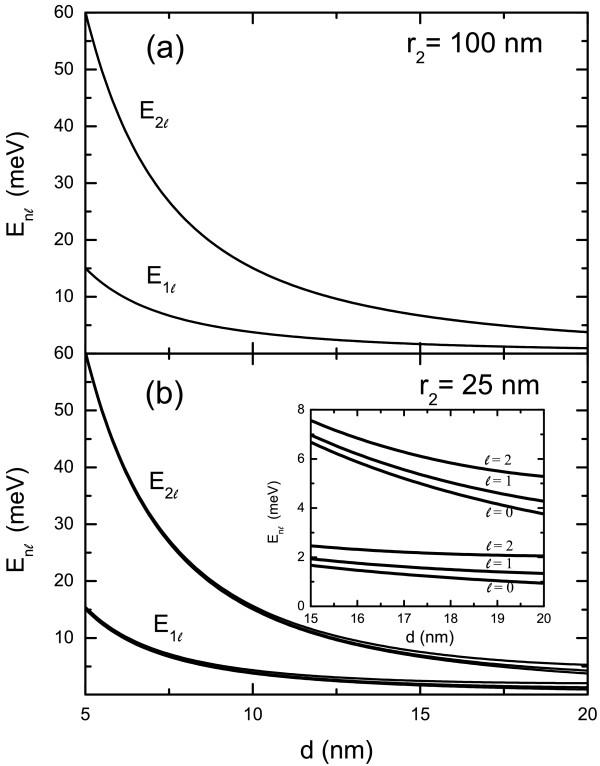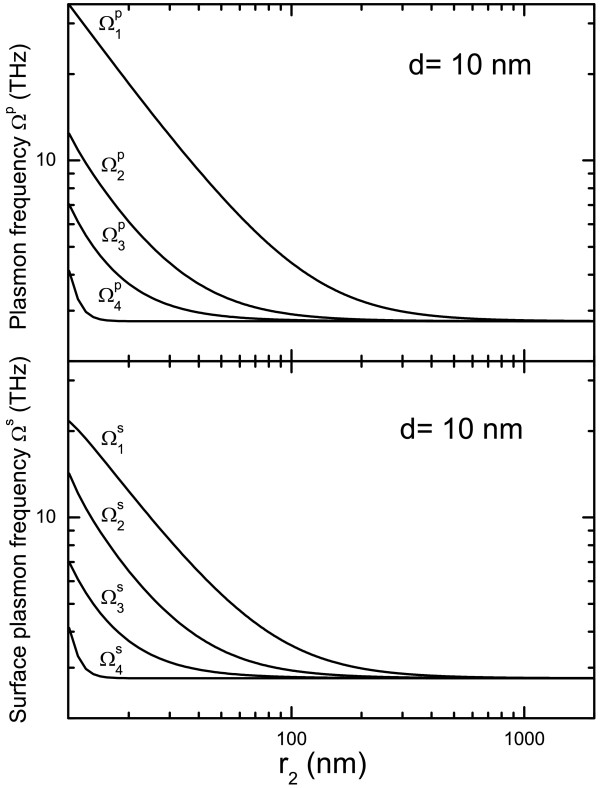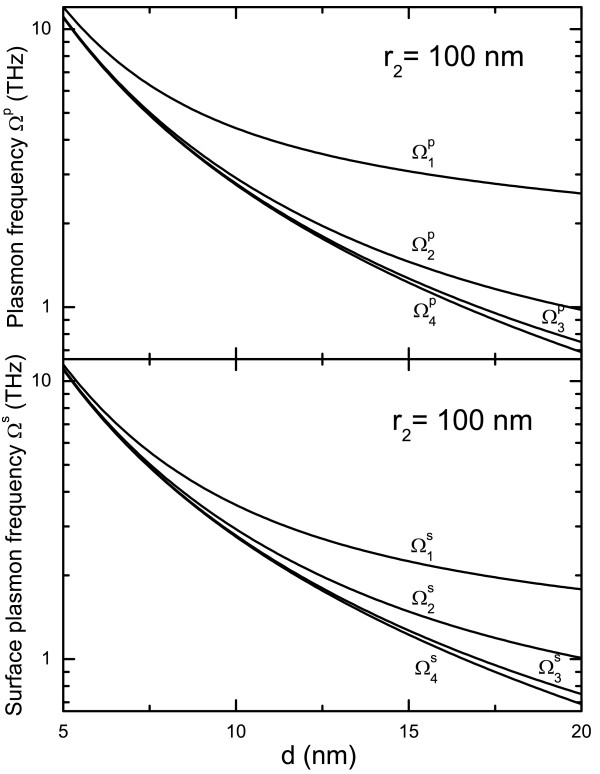Abstract
We present a theoretical study of the electronic subband structure and collective electronic excitation associated with plasmon and surface plasmon modes in metal-based hollow nanosphere. The dependence of the electronic subband energy on the sample parameters of the hollow nanosphere is examined. We find that the subband states with different quantum numbers l degenerate roughly when the outer radius of the sphere is r2 ≥ 100 nm. In this case, the energy spectrum of a sphere is mainly determined by quantum number n. Moreover, the plasmon and surface plasmon excitations can be achieved mainly via inter-subband transitions from occupied subbands to unoccupied subbands. We examine the dependence of the plasmon and surface-plasmon frequencies on the shell thickness d and the outer radius r2 of the sphere using the standard random-phase approximation. We find that when a four-state model is employed for calculations, four branches of the plasmon and surface plasmon oscillations with terahertz frequencies can be observed, respectively.
Keywords: Hollow nanosphere, Electronic subband structure, Collective excitation modes, Terahertz radiation
Background
In recent years, there has been a great interest in the investigation of metal-based hollow nanostructures because of their unique characteristics such as low density, large specific area, mechanical and thermal stability, and surface permeability. These advanced materials have been widely applied in catalysis [1], drug delivery [2,3], food and cosmetic industries [4], fuel cell [5,6], biotechnology [7], lubricant [8], sensing [9], photonic devices [10], micro/nanoreactors [11], etc. In particular, metal-based hollow nanospheres [12] can be realized via using polystyrene (PS) latex particles as templates [13]. Such structures have intriguing features of surface plasmon resonance [14]. The collective oscillations of the conducting electrons in response to optical excitation, such as plasmon and surface plasmon excitations, affect strongly the optical properties of metal hollow nanospheres. At present, it has become possible to fabricate metal hollow nanosphere structures in which the radius and shell thickness of the sphere can be controlled artificially. Such structures have been widely applied to realize terahertz (1012 Hz or THz) plasmonic devices [15]. Hence, it is of great importance and significance to study the electronic subband structure and corresponding collective electronic excitations from these advanced nanomaterial systems. In conjunction with recent experimental achievement in the field, in this article, we would like to develop a simple theoretical approach to study the electronic subband structure and plasmon and surface-plasmon modes in a hollow nanosphere. The aim of this study is to examine how sample parameters affect the electronic subband energy and the plasmon and the surface-plasmon modes in the device systems.
Methods
Theoretical approach
Electronic subband structure
In this study, we consider an air/metal-shell/air-based hollow nanosphere structure. The inner radius of the structure is r1, the outer radius or the diameter of the sphere is r2, and the metal shell thickness is d = r2 − r1. Such structure can be realized experimentally by selectively removing the hard spherical core (e.g., PS latex particles) in the fabrication process [16]. For a case where the electrons in the metal shell are not tunneling or hopping into the core and outside air, the confining potential for electrons in the structure can be modeled simply as
| (1) |
Thus, the corresponding Schrödinger equation takes a form
| (2) |
Here, P = (px,py,pz) is the momentum operator, μ is the effective mass for an electron in the structure, R = (x,y,z) = (r,θ,ϕ), and N stands for all quantum numbers. The solution of Equation (2) is , where N = (nlm),
| (3) |
and Rnl(r) is determined by
| (4) |
Here, l = 0,1,2,⋯ is the angular momentum quantum number, m = l,l−1,⋯,−l is the magnetic quantum number, is the associated Legendre function, and l must be a positive integer in the range l ≥ |m|. Letting EN = ℏ2k2/2μ, x = kr, and , the radial equation, Equation (4), for r1 ≤ r ≤ r2 becomes a Bessel equation with a general solution: , where Jα(x) is a Bessel function and is a normalization factor. Considering the boundary conditions: R(r1) = 0 and R(r2) = 0, we have
| (5) |
which is applied to determine the energy spectrum of the sample structure. Thus, the electron wave function becomes
| (6) |
For case of l = 0, we obtain En0 = ℏ2Π2n2/2μd2 with n = 1,2,⋯. The radial eigenfunction is
| (7) |
where k = nΠ/d.
For l = 1, we have
| (8) |
and the radial eigenfunction becomes
| (9) |
For l = 2, we get
| (10) |
En1 and En2 are determined numerically via solving respectively Equations (8) and (10).
Electron-electron interaction
The matrix element for the bare electron-electron (e-e) interaction can be obtained by applying the electron wave function to the interaction Hamiltonian induced by the Coulomb potential [17], which reads
| (11) |
with κ being the high-frequency dielectric constant of the shell material. It can be simplified as
| (12) |
Here, and are, respectively,
| (13) |
where as shown in Equation (3), and
| (14) |
where R< (R>) is the smaller (bigger) value of {R1,R2}. In order that ck can have a non-zero value, must satisfy the conditions
| (15) |
Table 1 gives the values of for s and p electrons in case of m = 0.
Table 1.
| lN | mN | c0(N′,N) | c1(N′,N) | c2(N′,N) | ||
|---|---|---|---|---|---|---|
|
s |
s |
0 |
0 |
1 |
|
|
|
p |
p |
0 |
0 |
1 |
|
4 |
| s | p | 0 | 0 | 1 |
lN and mN are angular momentum quantum number and magnetic quantum number for a quantum state N, respectively, whereas and for a quantum state N′. c0(N′,N), c1(N′,N), and c2(N′,N) are angle factors for defined by Equations (13) and (15).
Plasmon and surface-plasmon modes
From electron energy spectrum obtained from the solution of the Schrödinger equation, we can derive the retarded and advanced Green’s function for electrons. Applying these Green’s functions and Vαβ with β =N′N to the diagrammatic techniques to derive effective e-e interaction under the random phase approximation, the element of the dielectric function matrix is obtained as [17,18]
| (16) |
where
| (17) |
is the pair bubble (or density-density correlation function) in the absence of e-e coupling with gs = 2, counting for spin degeneracy, and f(EN) = being the Fermi-Dirac function.
In a hollow nanosphere system described by quantum number N = (nlm), the electronic subband energy depends only on n and l quantum numbers, namely EN = Enl. In this study, we consider that n = 1 states with many l and m numbers are occupied, and n = 2 states with any l and m numbers are unoccupied. For simplicity, we take a four-state model (FSM) to calculate the dielectric function matrix. We consider that two lowest electronic states for n = 1, E10, and E11 are occupied, and two lowest electronic states for n = 2, E20, and E21 are unoccupied, as shown in Figure 1. Because the electronic subband energy in a hollow sphere does not depend on the quantum number m, we take m = 0 in the calculations. On the basis that all electronic states in a hollow nanosphere are quantized, intra-subband transitions do not contribute to dielectric function. Moreover, the transitions within the occupied and within the unoccupied states do not contribute to the dielectric function as well. Thus, as shown in Figure 1, there are eight possible transition channels induced by inter-subband transitions from occupied (unoccupied) states to unoccupied (occupied) states in this FSM. Setting the electronic state index as 1 = (100), 2 = (110), 3 = (200), and 4 = (210), the dielectric function of a hollow nanosphere in the FSM is a 16×16 matrix and can be obtained from Equation (16). The determinant of the dielectric function matrix then is
Figure 1.
The four-state model for electronic transitions in a hollow nanosphere. E10 and E11 are occupied states, and E20 and E21 are unoccupied states. EF is the Fermi energy. Here, we consider the electronic states in the case of m = 0. The possible transition channels are indicated.
| (18) |
with aαβ = −Vαβπβ(Ω). The plasmon and surface-plasmon modes are determined by Re|ε(Ω)|→0 and Re|ε(Ω)|→−1, respectively. In this study, we employ a matrix to present the dielectric function in a multi-energy level system such as a hollow nanosphere structure. Such an approach was applied to study the plasmon excitations in semiconductor-based two-dimensional electron gas systems [19] and Rashba spintronic systems [18]. We note that in the present study, we consider a simple model to calculate the electronic subband structure of a hollow nanosphere. The effect of the spin-orbit interaction in the system is not included.
Results and discussion
In numerical calculations, we take the effective mass for an electron to be about the rest electron mass, i.e., μ ≃ 0.99me, and the high-frequency dielectric constant κ = 1.53 for gold shell [20-22]. In Figure 2, we show the electronic subband energy for E1l and E2l(l = 0, 1, and 2) as a function of outer radius r2 of the hollow nanosphere with a fixed shell thickness d = 10 nm. We see that the energy levels with different l quantum numbers roughly degenerate when r2 > 100 nm. In such a case, the subband energy depends very little on r2and Enl ≃ En0 = ℏ2Π2n2/2μd2. In Figure 3a, the electronic subband energies for E1l and E2l(l = 0, 1, and 2) are shown functions of shell thickness d at a fixed outer radius r2 = 100 nm of the hollow nanosphere. The results for different l states coincide roughly. The subband energy decreases with increasing shell thickness as Enl ≃ En0∼d−2. In Figure 3b, the electronic subband energies for E1land E2l(l = 0, 1, and 2) are shown functions of shell thickness d for a fixed outer radius r2 = 25 nm of the hollow nanosphere. The subband energies degenerate roughly at small shell thickness and show difference with increasing shell thickness d as shown in the inset in Figure 3b. We know that the energy for the nth subband at l = 0 is determined only by the shell thickness d = r2 − r1 of a hollow nanosphere. The results shown in Figures 2 and 3 indicate that different l states degenerate at a fixed n quantum number when r2 > 100 nm. This feature is mainly induced by the symmetry of the confining potential for electrons, given as Equation (1). However, when r2 is relatively small (see Figure 2 and Figure 3b), the electronic subband energy depends on quantum number l for a fixed quantum number n and Enl>En0 (here l > 0). This suggests that the stronger quantum effect can be achieved in smaller sample structures. Such an effect can be understood by the fact that when r2→∞, the energies determined by Equations (8) and (10) approach Enl → En0 = ℏ2Π2n2/2μd2 and when r2 takes a finite value Enl > En0.
Figure 2.
The subband energies vary with r2 at a fixed d. Electronic subband energy, E1l and E2lfor l = 0, 1, and 2, as a function of outer radius r2 of hollow nanosphere at a fixed shell thickness d = 10 nm.
Figure 3.
The subband energies vary with d at fixed r2. Electronic subband energy, E1l and E2lfor l = 0, 1, and 2, as a function shell thickness d of hollow nanosphere for outer radius r2 = 100 nm in (a) and r2 = 25 nm in (b). The inset in (b) shows the energy difference in different l states.
In Figure 4, the plasmon and surface-plasmon frequencies of hollow nanosphere are shown as a function of outer radius r2 at a fixed shell thickness d. Using the FSM, there are four modes for both plasmon and surface-plasmon excitation from a hollow nanosphere. We see that (1) the plasmon and surface-plasmon frequencies decrease with increasing r2 when r2 < 200 nm. When r2 > 200 nm, the plasmon and surface-plasmon frequencies approach approximately to the energy-gap between E20 and E10; (2) the frequencies of all these modes are in the THz regime; (3) the plasmon frequency with being a surface-plasmon frequency. This is the primary relationship between plasmon and surface-plasmon modes; (4) the surface-plasmon frequency is slightly higher than plasmon frequency ; and (5) and .
Figure 4.
Dependence of plasmon and surface-plasmon frequencies on outer radius r2 at a fixed shell thickness d = 10 nm.
In Figure 5, the plasmon and surface-plasmon frequencies are shown as functions of shell thickness d at a fixed r2. The plasmon and surface-plasmon frequencies decrease with increasing shell thickness. The frequency difference between different excitation modes gets wider with increasing d.
Figure 5.
Dependence of plasmon and surface-plasmon frequencies on the shell thickness d at a fixed outer radius r2 = 100 nm.
It should be noted that when r2 > 100 nm and d ∼ 10 nm, Enl ≃ En0, and plasmon and surface-plasmon frequencies in a hollow nanosphere are determined mainly by transition events between E2l and E1l. This implies that although only four electronic subbands are included within current calculations, the obtained results should be very much similar to the case where more electronic states are considered when r2 > 100 nm and d ∼ 10 nm. The results obtained from this study indicate that the electronic subband energy and the plasmon and surface-plasmon modes in hollow nanospheres are determined mainly by sample parameters such as the diameter of the sphere r2 and the shell thickness d. When r2 > 100 nm, the energy levels depend very weakly on inner or outer radius (i.e., r1 or r2) at a fixed d. Thus, the shell thickness affects more strongly the electronic subband energies in a hollow nanosphere. We find that when d ∼ 10 nm and r2 ≥ 100 nm, the energy spacing between E2l and E1l states is about 10 meV or about 2.4 THz. The frequencies of plasmon and surface-plasmon modes in the structure are also in the THz bandwidth. The plasmon and surface-plasmon modes depend sensitively on the geometrical parameters such as the outer radius r2 and shell thickness d. These effects imply that metal-based hollow nanosphere structures can be applied as THz materials or devices in which THz optical absorption and excitation can be achieved via inter-subband electronic transitions. It is known that THz technology is of great potential to impact many interdisciplinary fields such as telecommunication, biological science, pharmaceutical technology, anti-terrorist, etc. [23]. The application of nanostructure in THz technology has become a fast growing field of research in recent years. The theoretical findings from this work confirm that hollow gold-nanosphere structures are indeed the THz plasmonic materials which can be applied as frequency-tunable THz optoelectronic devices.
Conclusions
In this study, we have examined theoretically the electronic subband structure and the plasmon and surface-plasmon modes of hollow nanosphere structures. We have found that when the diameter of the sphere r2 > 100 nm and the shell thickness d ∼ 10 nm, the energy levels for different l states roughly degenerate. In such a case, the electronic subband energy, Enl ≃ En0 = ℏ2Π2n2/2μd2, does not depend on r2. When r2 < 200 nm, the plasmon and surface-plasmon modes induced by different electronic transition channels have significantly different frequencies. When r2 > 200 nm, the plasmon and surface-plasmon frequencies approach roughly to Ωp ∼ Ωs ∼ (E20 − E10)/ℏ, which depend largely on d and depend very little on r2.
It should be noted that at present, little research work has been carried out to look into the electronic subband structure of the hollow nanosphere structures using more powerful theoretical tools such as the first principle calculations which require large scale numerical computations and are CPU-consuming. The simple analytical results obtained from this study can be applied further to study the electronic and optoelectronic properties of the hollow nanosphere structures. We have found that the plasmon and surface-plasmon excitations can be achieved via inter-subband electronic transition channels in the hollow nanospheres. In particular, we have demonstrated that in metal hollow nanospheres, the energy difference between E1l and E2l states, and the plasmon and surface-plasmon frequencies are all in the THz bandwidth. This can lead to an application of metal hollow nanosphere structures in THz optics and optoelectronics.
Competing interests
The authors declare that they have no competing interests.
Author’s contributions
WX proposed and supervised the research work. YX carried out the analytical and numerical calculations. YZ and JH participated in the discussions and analyzes of the obtained results. All authors read and approved the final manuscript.
Author’s information
WX is the distinguished professor at Yunnan University and research professor at the Institute of Solid State Physics, Chinese Academy of Sciences. YX and YZ are post-graduate students at Yunnan University. JH is a PhD student at Yunnan University.
Contributor Information
Yiming Xiao, Email: ymxiao_ynu@163.com.
Wen Xu, Email: wenxu_issp@yahoo.cn.
Yaya Zhang, Email: yyzhang_ynu@163.com.
Jiaguang Hu, Email: ynshjg@126.com.
Acknowledgements
This work was supported by the National Natural Science Foundation of China (grant no.: 10974206), the Ministry of Science and Technology of China (grant no.: 2011YQ130018), the Department of Science and Technology of Yunnan Province, and by the Chinese Academy of Sciences.
References
- Shchukin DG, Caruso RA. Template synthesis and photocatalytic properties of porous metal oxide spheres formed by nanoparticle infiltration. Chem Mater. 2004;16:2287. doi: 10.1021/cm0497780. [DOI] [Google Scholar]
- Zhu YF, Shi JL, Shen WH, Dong XP, Feng JW, Ruan ML, Li YS. Stimuli-responsive controlled drug release from a hollow mesoporous silica sphere/polyelectrolyte multilayer core-shell structure. Angew Chem Int Ed. 2005;44:5083. doi: 10.1002/anie.200501500. [DOI] [PubMed] [Google Scholar]
- Chen JF, Ding HM, Wang JX, Shao L. Preparation and characterization of porous hollow silica nanoparticles for drug delivery application. Biomaterials. 2004;25:723. doi: 10.1016/S0142-9612(03)00566-0. [DOI] [PubMed] [Google Scholar]
- Shchukin DG, Sukhorukov GB, Möhwald H. Smart inorganic/organic nanocomposite hollow microcapsules. Angew Chem Int Ed. 2003;42:4472. doi: 10.1002/anie.200352068. [DOI] [PubMed] [Google Scholar]
- Liang HP, Zhang HM, Hu JS, Guo YG, Wan LJ, Bai CL. Pt hollow nanospheres: facile synthesis and enhanced electrocatalysts. Angew Chem Int Ed. 2004;43:1540. doi: 10.1002/anie.200352956. [DOI] [PubMed] [Google Scholar]
- Yang J, Lee JY, Too HP, Valiyaveettil S. A bis(p-sulfonatophenyl)phenylphosphine-based synthesis of hollow Pt nanospheres. J Phys Chem B. 2006;110:125. doi: 10.1021/jp055306c. [DOI] [PubMed] [Google Scholar]
- Mathiowitz E, Jacob JS, Jong YS, Carino GP, Chickering DE, Chaturvedi P, Santos CA, Vijayaraghavan K, Montgomery S, Bassett M, Morrell C. Biologically erodable microspheres as potential oral drug delivery systems. Nature. 1997;386:410. doi: 10.1038/386410a0. [DOI] [PubMed] [Google Scholar]
- Rapoport L, Bilik Y, Feldman Y, Homyonfer M, Cohen SR, Tenne R. Hollow nanoparticles of WS2 as potential solid-state lubricants. Nature. 1997;387:791. doi: 10.1038/42910. [DOI] [Google Scholar]
- Zhang Q, Zhang TR, Ge JP, Yin YD. Permeable silica shell through surface-protected etching. Nano Lett. 2008;8:2867. doi: 10.1021/nl8016187. [DOI] [PubMed] [Google Scholar]
- Prodan E, Radloff C, Halas NJ, Nordlander P. A hybridization model for the plasmon response of complex nanostructures. Science. 2003;302:419. doi: 10.1126/science.1089171. [DOI] [PubMed] [Google Scholar]
- Yin YD, Rioux RM, Erdonmez CK, Hughes S, Somorjai GA, Alivisatos AP. Formation of hollow nanocrystals through the nanoscale Kirkendall effect. Science. 2004;304:711. doi: 10.1126/science.1096566. [DOI] [PubMed] [Google Scholar]
- Caruso F, Caruso RA, Möhwald H. Nanoengineering of inorganic and hybrid hollow spheres by colloidal templating. Science. 1998;282:1111. doi: 10.1126/science.282.5391.1111. [DOI] [PubMed] [Google Scholar]
- Duan GT, Lv FJ, Cai WP, Luo YY, Li Y, Liu GQ. General synthesis of 2D ordered hollow sphere arrays based on nonshadow deposition dominated colloidal lithography. Langmuir. 2010;26:6295. doi: 10.1021/la904116p. [DOI] [PubMed] [Google Scholar]
- Lin A, Son DH, Ahn IH, Song GH, Han WT. Visible to infrared photoluminescence from gold nanoparticles embedded in germano-silicate glass fiber. Optics Express. 2007;15:6374. doi: 10.1364/OE.15.006374. [DOI] [PubMed] [Google Scholar]
- Polyushkin DK, Hendry E, Stone EK, Barnes WL. THz generation from plasmonic nanoparticle arrays. Nano Lett. 2011;11:4718. doi: 10.1021/nl202428g. [DOI] [PubMed] [Google Scholar]
- Lou XW, Archer LA, Yang Z. Hollow micro-/nanostructures: synthesis and applications. Adv Mater. 2008;20:3987. doi: 10.1002/adma.200800854. [DOI] [Google Scholar]
- Condon E, Shortley GH. The Theory of Atomic Spectra. London: Cambridge University Press; 1959,. p. 174. [Google Scholar]
- Xu W. Plasmons of a two-dimensional electron gas in the presence of spin orbit interaction. Appl Phys Lett. 2003;82:724. doi: 10.1063/1.1541098. [DOI] [Google Scholar]
- Das Sarma S, Madhukar A. Collective modes of spatially separated, two-component, two-dimensional plasma in solids. Phys Rev B. 1981;23:805. doi: 10.1103/PhysRevB.23.805. [DOI] [Google Scholar]
- Szczyrbowski J. A new simple method of determining the effective mass of an electron or the thickness of thin metal films. J Phys D: Appl Phys. 1986;19:1257. doi: 10.1088/0022-3727/19/7/015. [DOI] [Google Scholar]
- Johnson PB, Christy RW. Optical constants of the noble metals. Phys Rev B. 1972;6:4370. doi: 10.1103/PhysRevB.6.4370. [DOI] [Google Scholar]
- Etchegoin PG, Le Ru EC, Meyer M. An analytic model for the optical properties of gold. J Chem Phys. 2006;125:164705. doi: 10.1063/1.2360270. [DOI] [PubMed] [Google Scholar]
- Siegel PH. Terahertz technology. IEEE Trans Microwave Theory Tech. 2002;50:910. doi: 10.1109/22.989974. [DOI] [Google Scholar]







